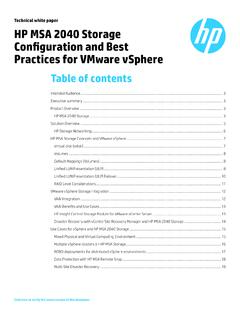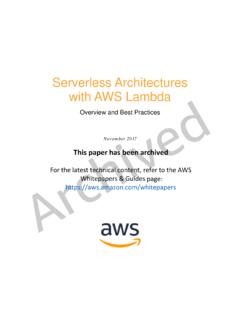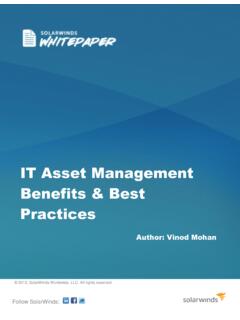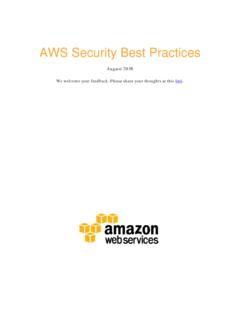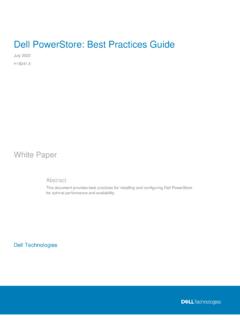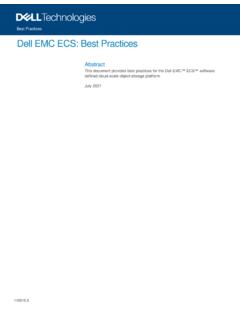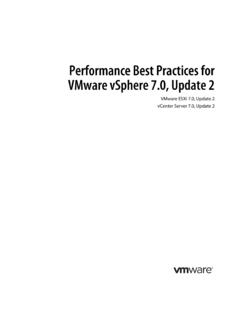Transcription of AWS Security Best Practices
1 ArchivedAWS Security best Practices August 2016 This paper has been archived. For the latest technical content on Security and Compliance, see Customers are responsible for making their own independent assessment of the information in this document. This document: (a) is for informational purposes only, (b) represents current AWS product offerings and Practices , which are subject to change without notice, and (c) does not create any commitments or assurances from AWS and its affiliates, suppliers or licensors. AWS products or services are provided as is without warranties, representations, or conditions of any kind, whether express or implied.
2 The responsibilities and liabilities of AWS to its customers are controlled by AWS agreements, and this document is not part of, nor does it modify, any agreement between AWS and its customers. 2020 Amazon Web Services, Inc. or its affiliates. All rights reserved. ArchivedContents Introduction .. 1 Know the AWS Shared Responsibility Model .. 2 Understanding the AWS Secure Global Infrastructure .. 3 Sharing Security Responsibility for AWS Services .. 4 Using the Trusted Advisor Tool .. 10 Define and Categorize Assets on AWS .. 10 Design Your ISMS to Protect Your Assets on AWS.
3 11 Manage AWS Accounts, IAM Users, Groups, and Roles .. 13 Strategies for Using Multiple AWS Accounts .. 14 Managing IAM Users .. 15 Managing IAM Groups .. 15 Managing AWS Credentials .. 16 Understanding Delegation Using IAM Roles and Temporary Security Credentials .. 17 Managing OS-level Access to Amazon EC2 Instances .. 20 Secure Your Data .. 22 Resource Access Authorization .. 22 Storing and Managing Encryption Keys in the 23 Protecting Data at Rest .. 24 Decommission Data and Media Securely .. 31 Protect Data in Transit .. 32 Secure Your Operating Systems and Applications.
4 38 Creating Custom AMIs .. 39 Bootstrapping .. 41 Managing Patches .. 42 Controlling Security for Public AMIs .. 42 Protecting Your System from Malware .. 42 ArchivedMitigating Compromise and Abuse .. 45 Using Additional Application Security Practices .. 48 Secure Your Infrastructure .. 49 Using Amazon Virtual Private Cloud (VPC) .. 49 Using Security Zoning and Network Segmentation .. 51 Strengthening Network Security .. 54 Securing Periphery Systems: User Repositories, DNS, NTP .. 55 Building Threat Protection Layers .. 57 Test 60 Managing Metrics and Improvement.
5 61 Mitigating and Protecting Against DoS & DDoS Attacks .. 62 Manage Security Monitoring, Alerting, Audit Trail, and Incident Response .. 65 Using Change Management Logs .. 68 Managing Logs for Critical Transactions .. 68 Protecting Log Information .. 69 Logging Faults .. 70 Conclusion .. 70 Contributors .. 70 Further Reading .. 70 Document 71 ArchivedAbstract This whitepaper is intended for existing and potential customers who are designing the Security infrastructure and configuration for applications running in Amazon Web Services (AWS). It provides Security best Practices that will help you define your Information Security Management System (ISMS) and build a set of Security policies and processes for your organization so you can protect your data and assets in the AWS Cloud.
6 The whitepaper also provides an overview of different Security topics such as identifying, categorizing and protecting your assets on AWS, managing access to AWS resources using accounts, users and groups and suggesting ways you can secure your data, your operating systems and applications and overall infrastructure in the cloud. The paper is targeted at IT decision makers and Security personnel and assumes that you are familiar with basic Security concepts in the area of networking, operating systems, data encryption, and operational controls. ArchivedAmazon Web Services AWS Security best Practices Page 1 Introduction Information Security is of paramount importance to Amazon Web Services (AWS) customers.
7 Security is a core functional requirement that protects mission- critical information from accidental or deliberate theft, leakage, integrity compromise, and deletion. Under the AWS shared responsibility model, AWS provides a global secure infrastructure and foundation compute, storage, networking and database services, as well as higher level services. AWS provides a range of Security services and features that AWS customers can use to secure their assets. AWS customers are responsible for protecting the confidentiality, integrity, and availability of their data in the cloud, and for meeting specific business requirements for information protection.
8 For more information on AWS s Security features, please read Overview of Security Processes Whitepaper. This whitepaper describes best Practices that you can leverage to build and define an Information Security Management System (ISMS), that is, a collection of information Security policies and processes for your organization s assets on AWS. For more information about ISMSs, see ISO 27001 at Although it is not required to build an ISMS to use AWS, we think that the structured approach for managing information Security that is built on basic building blocks of a widely adopted global Security approach will help you improve your organization s overall Security posture.
9 We address the following topics: How Security responsibilities are shared between AWS and you, the customer How to define and categorize your assets How to manage user access to your data using privileged accounts and groups best Practices for securing your data, operating systems, and network How monitoring and alerting can help you achieve your Security objectives This whitepaper discusses Security best Practices in these areas at a high level. (It does not provide how-to configuration guidance. For service specific configuration guidance, see the AWS Security Documentation.)
10 ArchivedAmazon Web Services AWS Security best Practices Page 2 Know the AWS Shared Responsibility Model Amazon Web Services provides a secure global infrastructure and services in the cloud. You can build your systems using AWS as the foundation, and architect an ISMS that takes advantage of AWS features. To design an ISMS in AWS, you must first be familiar with the AWS shared responsibility model, which requires AWS and customers to work together towards Security objectives. AWS provides secure infrastructure and services, while you, the customer, are responsible for secure operating systems, platforms, and data.










